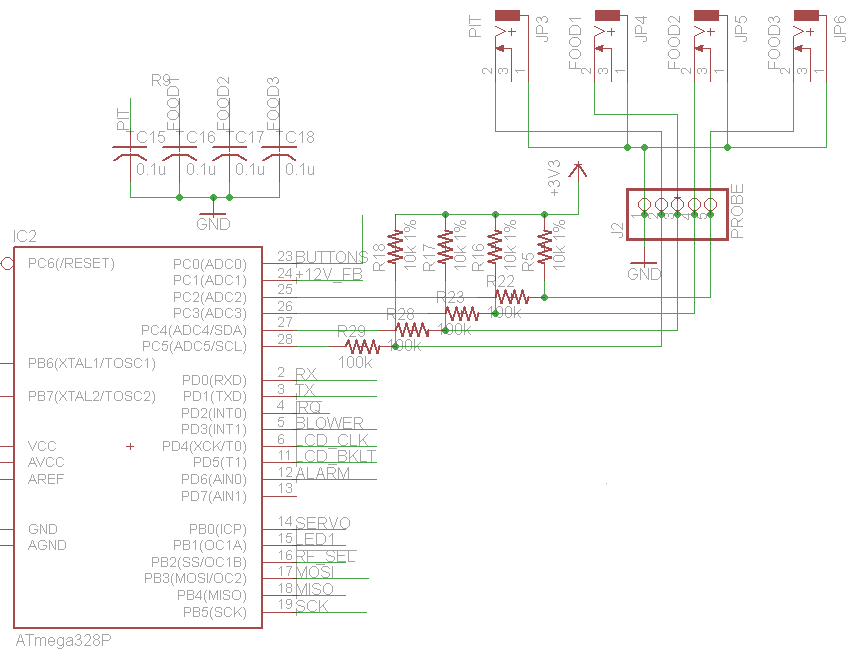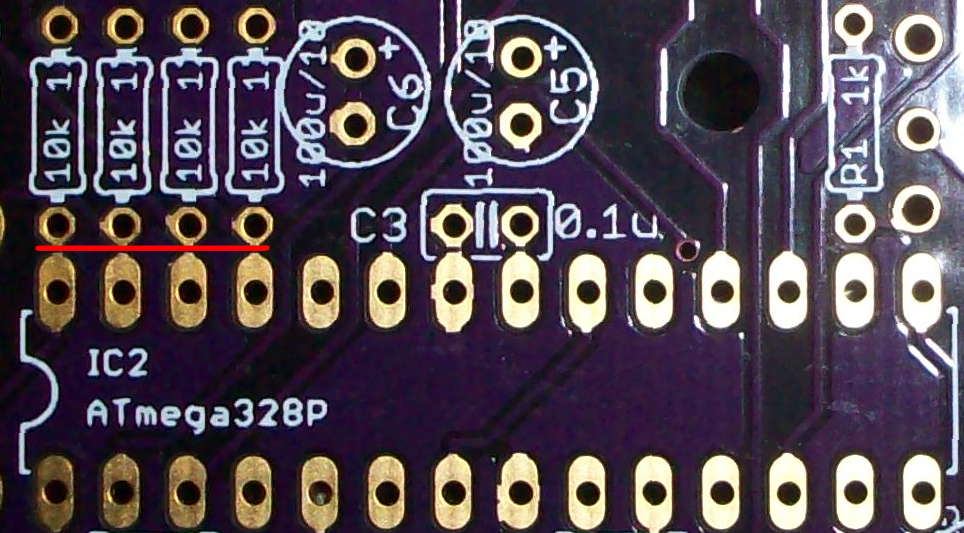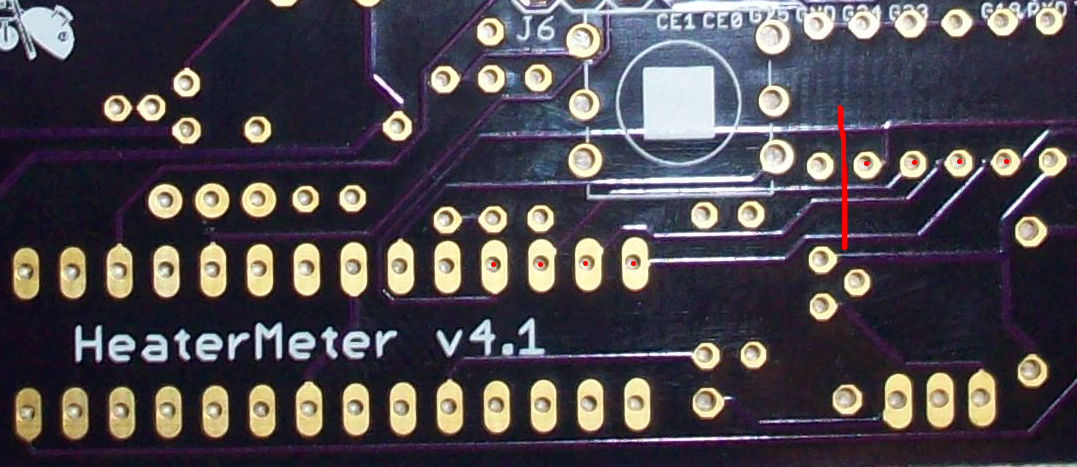-
Enter the TVWB 27th Anniversary Prize Drawing for a chance to win a Weber Traveler Portable Gas Grill! Click here to enter!
You are using an out of date browser. It may not display this or other websites correctly.
You should upgrade or use an alternative browser.
You should upgrade or use an alternative browser.
cat5 extender
- Thread starter NeilHeuer
- Start date
RalphTrimble
TVWBB Diamond Member
See my "Servo Booster" thread for details... That shows the simple NPN booster I came up with which works very well. On the v4.2 release Bryan changed over to using a MOSFET instead of an NPN because that board is running all MOSFETS and no NPN's.
Here is a shot of the MOSFET booster Bryan used on the v4.2.3 test board, which works just as well....

The other big improvement that has been made which makes longer CAT5 cables work better is the RC filter(s) Bryan added to the probe leads. These filters remove noise that is picked up over long cable runs and makes the probes read MUCH smoother whether connected directly to the HM or over a CAT5 cable.
These filters consist of just two components, a 100K resistor in SERIES between the probe and the ATMEGA, and a .1uf cap from the probe lead to ground. Here is a pic of the RC filters from the v4.2.3 schematic so you can see the position and orientation of the components.

The 10K resistors are the pullups that are present on your board now, unfortunately since the filter resistor is in series with the probe leads you would have to lift that lead and insert the resistor inline, the caps can just jumper from the probe tip lead to ground.....
Edit:
The forthcoming HMv4.2 release will have the servo booster and filters built onto the board, it has all the components completely re-arranged to isolate the power circuits from the sensor circuits, has an improved ground plain design, has a feedback circuit added to the blower driver to support additional (less noisy) operational modes. The HMv4.2 design is improved in lots of ways that will extend the viable length of your CAT5 cable. I'm not sure how much improvement you would net from just adding the filters cause I haven't tried that yet. (HMv4.2 also has optional onboard thermocouple pit probe support that works really well in my initial experiments) I encourage you to jump into the HMv4.2 project when it becomes official because it is just that good, a big step forward from previous releases IMHO...
Here is a shot of the MOSFET booster Bryan used on the v4.2.3 test board, which works just as well....

The other big improvement that has been made which makes longer CAT5 cables work better is the RC filter(s) Bryan added to the probe leads. These filters remove noise that is picked up over long cable runs and makes the probes read MUCH smoother whether connected directly to the HM or over a CAT5 cable.
These filters consist of just two components, a 100K resistor in SERIES between the probe and the ATMEGA, and a .1uf cap from the probe lead to ground. Here is a pic of the RC filters from the v4.2.3 schematic so you can see the position and orientation of the components.

The 10K resistors are the pullups that are present on your board now, unfortunately since the filter resistor is in series with the probe leads you would have to lift that lead and insert the resistor inline, the caps can just jumper from the probe tip lead to ground.....
Edit:
The forthcoming HMv4.2 release will have the servo booster and filters built onto the board, it has all the components completely re-arranged to isolate the power circuits from the sensor circuits, has an improved ground plain design, has a feedback circuit added to the blower driver to support additional (less noisy) operational modes. The HMv4.2 design is improved in lots of ways that will extend the viable length of your CAT5 cable. I'm not sure how much improvement you would net from just adding the filters cause I haven't tried that yet. (HMv4.2 also has optional onboard thermocouple pit probe support that works really well in my initial experiments) I encourage you to jump into the HMv4.2 project when it becomes official because it is just that good, a big step forward from previous releases IMHO...
Last edited:
RalphTrimble
TVWBB Diamond Member
I just looked up the pic I took of my HMv4.0 board before I built it to see how I might go about mod'ing it to include the filters...
It looks like the probe traces are on the top side of the board, very short between the pullup resistors and the ATMEGA. In order to install the filters it seems you would have to cut those four traces between the pullups and the ATMEGA, then install a 100K resistor between the pullup resistor solder joint and the ATMega pin, and then put the .1uf cap from the probe lead to ground, probably at the probe jack would be easiest.
Here is a pic of a HMv4.0 board that shows what I am talking about...

It looks like the probe traces are on the top side of the board, very short between the pullup resistors and the ATMEGA. In order to install the filters it seems you would have to cut those four traces between the pullups and the ATMEGA, then install a 100K resistor between the pullup resistor solder joint and the ATMega pin, and then put the .1uf cap from the probe lead to ground, probably at the probe jack would be easiest.
Here is a pic of a HMv4.0 board that shows what I am talking about...

RalphTrimble
TVWBB Diamond Member
I just looked up my pics of the HMv4.1 board I took before I built and it seems the traces for the probes are on the bottom side of the board on this one. Here is a pic of the board showing a suggested spot to cut the traces so you can solder the 100K resistor in series between the pullup resistor junction and the ATMega. I put dots on the ATMega pins for the probes and also on the pullup resistors since the parts designation is not printed on this side of the board...


RalphTrimble
TVWBB Diamond Member
Ralph how does that 5v output work. Is there a way I can have that on to power a Arduino Uno
Hmm, "5v Output", not really sure how to answer that question... The DC-DC converter board reduces the 12VDC from the wall wart down to 5VDC which is used to power the rPi, the servo booster and the LCD (it is further reduced by the 3.3V regulator to power most everything else). I would think you should be able to tap onto the +5v somewhere and power an Arduino with it, but I don't have all the current calculations to tell you whether that is too much draw through the DC-DC converter or not.
RalphTrimble
TVWBB Diamond Member
Well, same goes for the +5v that is on the CAT5 cable too, that is there to power the servo but you should be able to use it to power "whatever" as long as you don't draw more current than it is capable of providing....
RalphTrimble
TVWBB Diamond Member
OK, well... you can jumper over the probe leads to the CAT5 jack and send them (2 with HMv4.0, 3 with HMv4.1 or later) down the CAT5 cable along with the servo and blower connections. It will work with all HM versions reasonably as well with a short to mid-length CAT5 cable. If you want to use an EXTENDED length CAT5 cable then the servo booster circuit helps the servo not flake out, and the improvements in the design that limit noise on the probes will make them read more stable...
RalphTrimble
TVWBB Diamond Member
Maybe I misread your question since the thread subject is "CAT5 Extender"...
You didn't mention what HM board version you are running? Do you mean you have a HMv4.0 (without a CAT5 jack) and want to add a CAT5 jack to it? In that case, I posted details about the suggested wiring of the CAT5 jack and mod'ing my HMv4.0 case to fit in a CAT5 jack in my Roto Damper thread. Read through those pages and you should find the info you seek there. Tom also offers a HMv4.0 case that has a built in spot to put the CAT5 jack if you don't want to attempt the surgery on the one you have, or if you have a version of the case that is too small to fit it in...
Wiring diagram for the CAT5 jack is shown on Page 20, and info on adding the CAT5 jack to my HMv4.0 is shown on page 13 of the roto damper thread...
You didn't mention what HM board version you are running? Do you mean you have a HMv4.0 (without a CAT5 jack) and want to add a CAT5 jack to it? In that case, I posted details about the suggested wiring of the CAT5 jack and mod'ing my HMv4.0 case to fit in a CAT5 jack in my Roto Damper thread. Read through those pages and you should find the info you seek there. Tom also offers a HMv4.0 case that has a built in spot to put the CAT5 jack if you don't want to attempt the surgery on the one you have, or if you have a version of the case that is too small to fit it in...
Wiring diagram for the CAT5 jack is shown on Page 20, and info on adding the CAT5 jack to my HMv4.0 is shown on page 13 of the roto damper thread...
Last edited:
